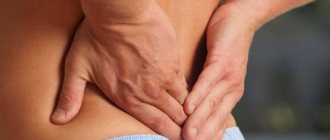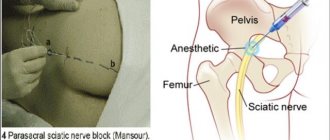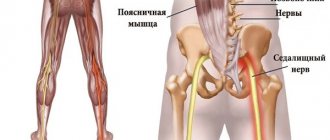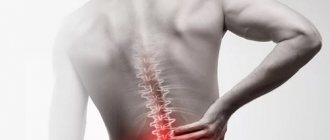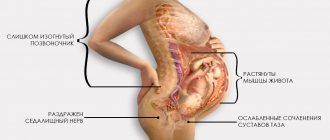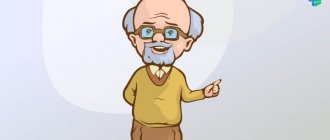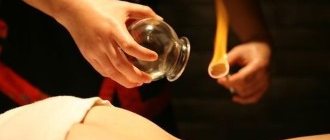Why does pathology occur?
Doctors consider primary and secondary neuropathy. The primary cause is injuries, infectious diseases and hypothermia. The list of reasons that can cause a secondary type of illness is much more extensive. These include:
- disc displacement;
- neoplasms of any nature;
- osteochondrosis;
- protrusion;
- osteophytes;
- spasmodic muscles;
- curvature of the ridge;
- tunnel syndrome;
- intervertebral hernia;
- post-injection suppuration.
Forms of neuralgia of the facial nerve
- neuritis – minor inflammation of the facial nerve (or part of it),
- paresis is a partial lesion in which weakness of the facial muscles and slight numbness are observed. This disease usually falls into the neurological category. But, like complete paralysis, it can be a consequence of advanced neuritis,
- paralysis - complete defeat. This is a severe stage, in which there is numbness of the face (usually one part of it) and blocking of muscle motor activity.
Symptoms of neuralgia
- tingling or sharp “sliding” pain,
- numbness of a certain part or the entire half of the face, lack of sensitivity and motor activity,
- drooping eyelids and skin around the eyes,
- drooping corners of the lips (on the side where muscle paralysis is observed),
- smoothing out wrinkles on the cheeks and forehead,
- pronounced facial asymmetry.
Causes of neuralgia
- viral infection or inflammatory processes (ear, throat, nose),
- hypothermia,
- inflammatory processes in the roots of teeth and bone tissue of the jaw,
- nerve injury during tooth extraction or installation of implants,
- injury from a needle during the administration of anesthesia,
- jaw injuries,
- old age and natural aging of the body.
The facial nerve belongs to the group of cranial nerves (along with the trigeminal nerve, whose branches are the mandibular and maxillary nerves). It also consists of many branches that run through almost the entire human skull. Depending on which branch is affected, the numbness of a certain part of the face will depend. In relation to implantation or complex surgical interventions, it is the trigeminal nerve that can be damaged.
Symptoms of inflammation of the sciatic nerve
Pain, which can even occur due to lifting a heavy bag or hypothermia, night attacks are the main indicator of sciatica. In addition to the sharp shooting pain syndrome, doctors advise paying attention to:
- “pins and needles” and numbness from the buttocks and below;
- constipation, urinary incontinence;
- weakness and gradual muscle atrophy, limping.
When a person moves or stands for a long time, pain is more disturbing. During attacks, redness of the skin, swelling, chills, and sweating are quite possible. At first, the pain syndrome is not very expressive, but gradually becomes so strong that there is a danger of loss of consciousness. It almost hurts for a person to breathe. If the disease is not treated, the entire leg will suffer: it will become cold, bending and unbending it will be problematic, and then the ability to move the foot and toes will be lost.
Causes
The reasons for the development of persistent pathological spasm of the piriformis muscle and changes in it (thickening of its abdomen) may be:
- Myofascial pain syndrome caused by various types of injuries (unsuccessful injections of drugs, bruise/strain of the pelvic muscles).
- Chronic static/dynamic reload (staying in one position for a long time, high physical loads on the pelvic muscles).
- Twisted pelvis syndrome of various origins (different lengths of the lower limbs, S-shaped scoliosis).
- Blockade of the function of the sacroiliac joint.
- Pathology of the hip joint (coxathrosis).
- Disease of an infectious-inflammatory nature (gynecological diseases)/pathology of the urogenital zone, contributing to reflex spasm of the piriformis muscle.
- Hypothermia of the pelvic area.
- Vertebrogenic pathology (osteochondrosis of the lumbosacral region, lumbosacral dorsopathy, lumbar stenosis).
Pinching symptoms
Doctors consider several syndromes that indicate that the patient has a pinched nerve.
- Lesera – straight leg does not rise;
- Sikara – pain intensifies if a person bends the foot;
- landing - it is impossible to take a sitting position yourself.
It hurts to walk and squat, but if you lie down or sit with your legs spread wide apart, it goes away. Signs of inflammation and pinching of the sciatic nerve are quite expressive, but they can still be confused with other diseases:
- spondylitis;
- myeloma;
- ankylosing spondylitis;
- phlebothrombosis;
- arterial insufficiency.
The causes of this disease are as follows:
- Herniated disc in the lower back. The spinal roots become pinched and irritated, which provokes sciatica;
- Osteochondrosis. Unstable motor segments and reactive inflammation in the lesion can pinch the spinal cord roots;
- Spondylolisthesis is a pathology that provokes a slight displacement of the vertebrae horizontally to each other;
- Spinal stenosis is a consequence of the proliferation of cartilage, bone and other tissues with subsequent penetration into the spinal canal. All this can cause compression of the spinal nerve. Sciatica is most common in older people;
- Piriformis syndrome - the sciatic nerve is located under the piriformis muscle, which compresses it. This causes irritation and pain.
- The sacroiliac joint is disrupted - its mobility increases, and the nerve is pinched, resulting in sciatica.
How to make a diagnosis
The disease is determined by a neurologist based on the results of motor tests that reveal the presence of the syndromes described above. But laboratory and instrumental studies are still necessary. As a rule, they are limited to x-rays in two planes. It may be necessary to obtain a more clear picture of the condition of the spine. In this case, a tomography will be prescribed. A radioisotope scan is done if a tumor is suspected.
When a person has inflammation of the sciatic nerve, treatment at home is not always acceptable, because the disease can manifest itself in such a serious form that the patient is prescribed bed rest in a hospital setting. Nerve-related illnesses must be taken seriously or you may lose your ability to move.
An immediate visit to a doctor is necessary in the following cases:
- severe numbness that prevents you from moving;
- increased body temperature;
- transfer of pain to other locations;
- incontinence of metabolic products;
- swelling in the lower part of the ridge.
Medicines
Ledocaine, Ketanov, Indomethacin - first aid against pain from an inflamed tooth nerve.
You can name several of the most popular medications that are used as an anesthetic for inflammation of the dental nerve:
- Ledocaine is a very well-known local anesthetic used in various fields of medicine. To anesthetize the inflamed nerve, apply the drug (gel) to a cotton swab and apply to the affected area for fifteen minutes. If you bought the drug in the form of a spray, then spray about 20 mg on the aching tooth, repeat the procedure every hour and a half, the maximum dose per day is 20 procedures. Before starting treatment with Ledocaine, read the instructions, especially the “Contraindications” section.
- Ketanov , usually widely used in tablet form. Do not exceed the daily dose of 5 pcs. and do not take the drug for more than one week. The greatest effect is when taken before meals. Much superior to the usual Analgin and Indomethacin. The action lasts up to eight hours. There are a number of contraindications.
- Indomethacin is a good pain reliever, taken three times a day; if the effect is not sufficiently pronounced, the dose can be increased to 50 mg. It is better to use after meals and wash down with milk. With prolonged use, exacerbations of chronic diseases are possible. It is advisable to read the instructions carefully before use.
All these drugs will help relieve attacks of severe pain, but do not forget that only a visit to the dental office can relieve you of the disease itself and help avoid possible complications.
Moscow metro station Zvezdnaya, Danube Avenue, 23
How to treat inflammation of the sciatic nerve
Treatment measures are aimed at:
- relieving the patient of pain;
- improved sensitivity of the limbs;
- restoration of leg functionality.
To achieve this, they resort to methods of traditional and alternative medicine. Treatment begins with pain relief. Then physiotherapy, therapeutic exercises, and manual therapy come into play. In parallel, the rich experience of traditional medicine can be used.
Medicines prescribed for the treatment of sciatica include the following groups of drugs:
- non-steroidal;
- corticosteroids;
- vitamin complexes;
- biogenic stimulants;
- muscle relaxants;
- decongestants;
- angioprotectors.
External means are widely used - warming creams and ointments, which contain snake or bee venom, hot pepper, camphor, turpentine. Massage for inflammation of the sciatic nerve helps improve blood circulation and restore muscle tone.
A huge role in restoring leg functions belongs to physiotherapeutic procedures, for example, magnetic and laser therapy, electrophoresis, and dynamic current treatment. Various types of physical exercises, selected for a specific patient, reduce muscle spasms and strengthen the body.
To heal at home, you will have to be patient, since sciatica responds better to the efforts of professionals. There are cases when the disease started precisely because of insufficiently active therapeutic measures. The more complex the case, the more effective drugs have to be prescribed. So, if non-steroidal drugs do not help, although a person takes them for a long time, steroid drugs are prescribed, which have significant side effects.
In many clinics, in addition to the main treatment, patients undergo courses:
- acupuncture;
- ozone therapy;
- herbal medicine;
- cupping and vacuum massage;
- stone therapy;
- treatment with leeches;
- cauterizations.
Many recipes for compresses, lotions, and tinctures have been developed. But it is better not to try them on yourself without consulting your doctor. The doctor knows where and how they can help or harm. Therefore, it is necessary to consult.
Spa and hydrotherapy is an excellent way to improve overall health and regulate various pathologies, including inflammation of the sciatic nerve, the symptoms and treatment of which, due to their diversity and complexity, require long-term and careful attention.
If therapeutic methods do not produce results, the nerve has to be decompressed. This is done surgically.
It is not enough to know how to treat sciatica, that is, inflammation of the sciatic nerve. It is necessary to be aware of how to protect yourself from such a serious, life-spoiling and health-robbing illness.
Among the preventive measures, doctors recommend the following:
- do not freeze;
- strengthen immunity;
- lift weights correctly;
- develop posture;
- sleep on hard mattresses;
- beware of sudden movements.
A healthy body significantly increases the likelihood that the spine will work correctly, and the nerve roots will avoid inflammation and will not be pinched.
We specialize in the treatment of the musculoskeletal system, even in severe stages of disease. We have been helping thousands of patients avoid surgery for 10 years!
Our doctors
This is the strongest team of experts who teach at the RUDN Department. We are the clinical base of leading universities, where the best doctors in Moscow, unique specialists from Russia and abroad are trained.
Treatment methods
- Acupuncture – helps repair damaged tissues and nerves, as well as blood vessels. Improves blood circulation and increases qi in the blood.
- Bloodletting helps get rid of blood clots and stagnation, cleanses the blood of toxins and after that, clean, fresh blood flows through the blood vessels. And also after this procedure, the muscles and body will be relaxed, and lightness will be felt throughout the body.
- Traditional Chinese medicines - which help restore blood vessels, organs, internal secretions/immune system, and also nourish the entire body. These natural herbal medicines not only provide pain relief but also heal from the inside out.
! Treatment must be completed for at least 10 sessions and the doctor must examine your condition after 10 procedures to determine whether it is worth continuing treatment or whether you can rest. Every year it is recommended to come for re-checking and preventive maintenance to keep your body healthy.
Treatment of lesions of the facial or trigeminal nerve
The first thing to do (if the cause of the lesion is not known) is to undergo a full diagnosis and find out why this problem occurred. This will allow the doctor to choose the right treatment tactics.
It is very important to consult a doctor as soon as possible if you experience the first symptoms of complications after tooth extraction or implant installation. If treatment is started promptly, complete restoration of muscle functionality can be achieved. It is also important that if numbness persists for 3 months and no measures have been taken, it will most likely not be possible to restore the affected nerve, since persistent degenerative changes develop in it.
Diagnostics
- a blood test to check for a viral or bacterial infection that could cause nerve damage,
- CT or MRI of the skull and brain to determine the affected area,
- electromyography, which involves direct impact on nerve endings to determine the level of disturbance in the passage of impulses along the nerve.
Treatment
- drug therapy: this group includes anti-inflammatory, painkillers and anticonvulsants, as well as antidepressants and sedatives.
- physiotherapy: facial gymnastics, massage performed by specialists, electrical stimulation and acupuncture,
- microsurgery: surgery is performed to restore the integrity of the damaged nerve. This is a fairly serious surgical procedure that should be performed by a professional surgeon. Surgery is an extreme method of solving the problem; it is needed only in case of serious damage and if the first two options did not bring any result.
